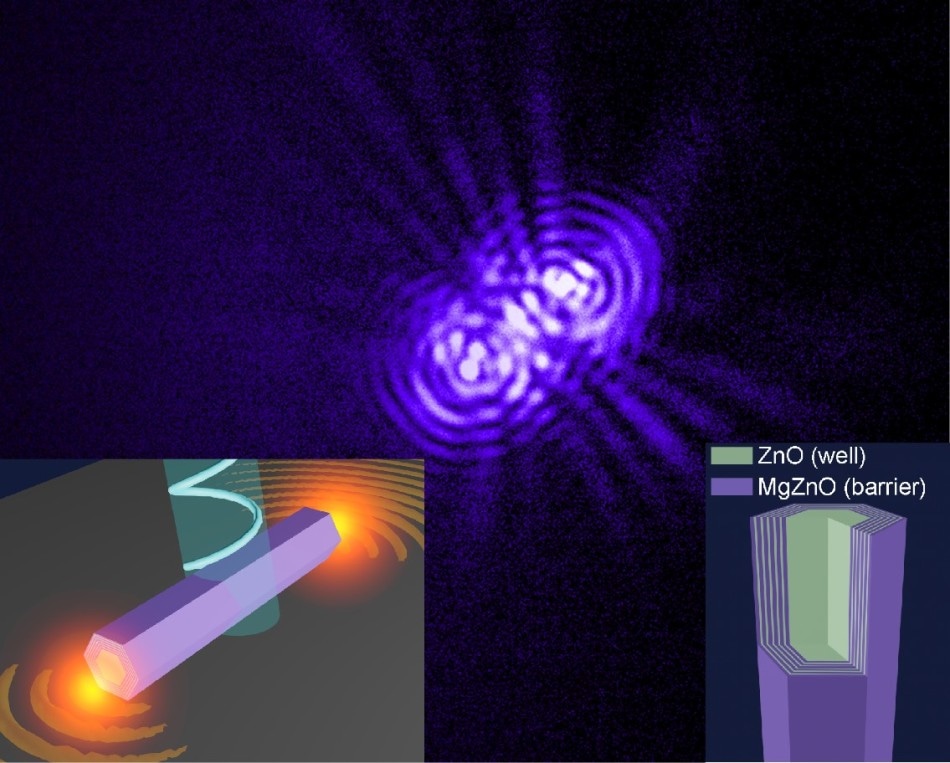May 21 2019
DGIST researchers have demonstrated a room temperature polariton nano-laser, offering the vital path of related research such as polariton physics at the nanoscale and also applications in quantum information systems. The study was reported in the Science Advances journal.
 Coherent light emission of one-dimensional polaritons in the quantum well nanocavity. Above the lasing threshold, the interference pattern, which is associated with Fabry-Pérot cavity modes along the long axis of the nanorod (left inset), is observed. The radial quantum wells integrated on the sidewall of the nanorod (right inset) provide the enhanced thermal stability and oscillator strength of excitons to achieve the room-temperature polariton lasing. (Image credit: DGIST)
Coherent light emission of one-dimensional polaritons in the quantum well nanocavity. Above the lasing threshold, the interference pattern, which is associated with Fabry-Pérot cavity modes along the long axis of the nanorod (left inset), is observed. The radial quantum wells integrated on the sidewall of the nanorod (right inset) provide the enhanced thermal stability and oscillator strength of excitons to achieve the room-temperature polariton lasing. (Image credit: DGIST)
On May 8th, 2019, DGIST announced that a polariton nano-laser working at room temperature was created by Professor Chang-Hee Cho’s team in the Department of Emerging Materials Science, together with Professor Seong-Ju Park at GIST and Professor Ritesh Agarwal at University of Pennsylvania. When a material excited by forming Coulomb-bound states of electron-hole pairs (excitons) strongly interacts with photons, a macroscopic quantum state of exciton-polaritons is created and gains benefits of the light as well as the matter, leading to highly energy-efficient coherent light sources, known as “polariton lasers.”
The polariton laser is gaining much attention as the next generation laser technology as it can function at ultralow power. However, its development has been restricted because of the problems in controlling the thermal stability of excitons, particularly in nanoscale devices.
To overcome such drawback, the team of scientists employed “quantum well,” which was named so to denote a space where electrons fall easily. Research Fellow Dr Jang-Won Kang at DGIST incorporated a quantum well on the sidewall of nanostructure semiconductor and succeeded in maintaining thermally stable excitons even at room temperature, or else they are stable only at extremely low temperatures.
Moreover, the quantum well structure contributed to the development of more efficient and stable exciton-polariton states than before by making the pairing of exciton and light stronger inside the nanostructure semiconductor. This turned out to be the solid foundations for Professor Chang-Hee Cho’s team to create the polariton nano-lasers, which are stable at room temperature and function at only 1/10th power of current nano-lasers.
Since the new nanostructure semiconductor can boost the properties of excitons and thus the exciton-polaritons, we were able to develop the polariton nano-lasers that can operate at room temperature using this technology. Especially, we are very happy because we can now contribute to building a platform to study the physical phenomena related to the exciton-polaritons at room temperature.
Professor Chang-Hee Cho, Department of Emerging Materials Science, DGIST